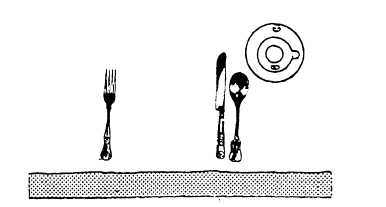| |
Sideboard
all meals for serving butter patties. At breakfast or
brunch, it can be used for serving jam or jelly packets.
Pickle fork—The pickle fork is used only at lunch
or dinner when pickles or other relishes are served. It is
placed on the relish (bread) tray. The pickle fork has
three tines and is similar in shape to the diner’s oyster
fork but is slightly larger.
The buck—A buck is normally a small object such
as a statue, a model, or a dummy weapon round. The
buck is used aboard some ships to designate which diner
is to be served first. It is not used at breakfast, at brunch,
or when guests are to be served.
Meal-related items are selected on the basis of menu
requirements.
Examine the menu and identify those
menu items for which related center items are normally
used, such as jellies and syrup at breakfast. Pencils are
supplied for falling out order forms.
For semiformal lunch or dinner, the bread, if served,
is placed on the dining table after the main course item.
For all informal-style lunch or dinner meals, bread is set
5 minutes before the meal.
DINING TABLE
When assigned to wardroom duty, you are
responsible for setting the table for meals. Setting a
table correctly helps avoid confusion at meals and
allows the table to look neat and attractive. An
attractively set table contributes to the enjoyment of the
meal.
Linens
Linen is handled when preparing for a meal and
when securing from a meal. All linen should be
examined for cleanliness and serviceability before use.
When linen is stained, torn, or frayed, it is not suitable
for the table. Linen in this condition should be brought
to the attention of the wardroom supervisor.
Linen Placements
All linen should be in place before the wardroom
tables can be set. Linen also should be placed on the
sideboard and, sometimes when appropriate, the buffet
table. Linen that is worn, but clean and without stains,
may be used on the sideboard if it can be neatly folded
so the damaged parts are hidden.
Most wardrooms have a waist-high cabinet known
as the sideboard. Its storage spaces are used for storing
wardroom linen and tableware. The top forms a counter
for the placement of hot and cold beverage services and
extra tableware in preparation for a meal.
Napkins
When cloth napkins are to be used alongside plate
settings, they should be folded flat and set aside. If
napkin rings are to be used, napkins should be folded,
rolled, and placed in the rings.
SETTING THE TABLE
Setting the dining table involves two basic tasks:
setting individual place settings and setting the dining
table center items.
Steps for selecting and placing
individual place settings and dining table center items
are dependent on specific menus and styles of meal
service. Variations in the procedures may recur. These
variations are based on the way a specific mess maybe
equipped and on the desires of the mess president and/or
the wardroom supervisor. For instance, if there is a lack
of a certain type of needed tableware, the wardroom
supervisor should be asked to decide what item should
be used as a substitute.
Setting Individual Place Settings
The dishes, silver, glasses, and napkin placed in
front of one person are called a cover. The number of
dishes and pieces of silver necessary for a cover depends
on the occasion and the menu. Everyday meals require
fewer dishes and silver than formal meals. Always
check the menu before setting the table. Figures 9-3,
Figure 9-3.—Basic breakfast or brunch cover.
9-11
|

